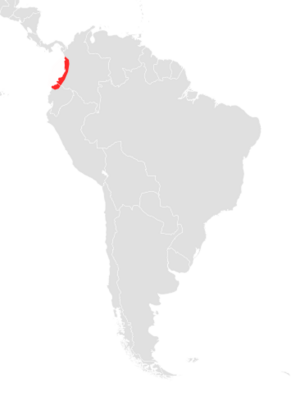Greater long-tailed bat facts for kids
Quick facts for kids Greater long-tailed bat |
|
|---|---|
| Conservation status | |
| Scientific classification | |
| Genus: |
Choeroniscus
|
| Species: |
periosus
|
 |
|
| Greater long-tailed bat range | |
The greater long-tailed bat (Choeroniscus periosus) is a special type of bat. It belongs to a family of bats called Phyllostomidae, which are also known as New World leaf-nosed bats. This particular bat is found in two countries in South America: Colombia and Ecuador.
Contents
About the Greater Long-tailed Bat
Bats are amazing flying mammals. The greater long-tailed bat is named for its long tail, which helps it steer while flying. These bats are usually quite small. They have a unique nose shape that helps them find food.
What Does It Look Like?
The greater long-tailed bat has soft fur that can be different shades of brown or gray. Its wings are made of thin skin stretched between its long fingers and body. Like many bats, it has large ears to help it hear very well. Its nose has a small, leaf-like shape. This "nose-leaf" helps direct the sounds it makes for echolocation.
Where Does It Live?
This bat lives in tropical areas of Colombia and Ecuador. It prefers forests, especially those with many trees and plants. Bats often live in dark, safe places during the day. These places can be caves, hollow trees, or even abandoned buildings. At night, they fly out to find food.
What Does It Eat?
The greater long-tailed bat is a nectarivore. This means its main food is nectar from flowers. It has a long tongue that it uses to reach deep inside flowers. While drinking nectar, pollen sticks to its fur. When it visits another flower, it carries the pollen with it. This process is called pollination. It is very important for plants to make seeds and fruits. Sometimes, these bats might also eat small insects.
Life Cycle and Reproduction
Like all mammals, greater long-tailed bats give birth to live young. A baby bat is called a pup. Mother bats usually have one pup at a time. The pup is born tiny and helpless. It drinks milk from its mother until it is big enough to fly and find its own food. Bats often live in groups called colonies. This helps them stay safe and raise their young together.
Why Are They Important?
Bats play a very important role in their ecosystems. Nectar-feeding bats like the greater long-tailed bat are natural pollinators. They help many plants grow and reproduce. Without bats, many plants would struggle to survive. This could affect other animals that depend on those plants for food or shelter.
Conservation Status
The greater long-tailed bat is listed as "Vulnerable" (VU) by the International Union for Conservation of Nature (IUCN). This means that its population is decreasing. It faces threats like habitat loss. When forests are cut down, bats lose their homes and food sources. Protecting their habitats is very important to help these unique bats survive.
See also
 In Spanish: Choeroniscus periosus para niños
In Spanish: Choeroniscus periosus para niños


